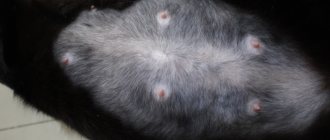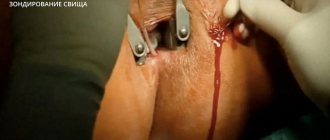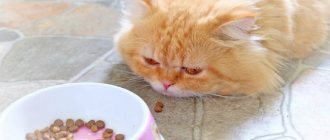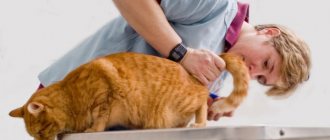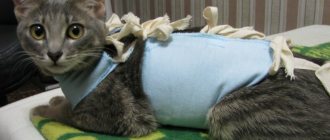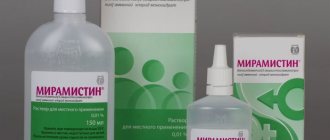11348Administration
Sterilization is considered an absolutely safe veterinary operation, which has been successfully performed all over the world for many years, but whatever it is, it is an intervention in the nature of the animal and it is always difficult to predict how it will affect the cat. Often owners are faced with the problem that the cat has become aggressive after sterilization.
An animal that has been docile and gentle for many years suddenly suddenly shows attacks of aggressiveness, rushes and hisses at its owners, and sometimes can even scratch painfully.
Coming out of anesthesia
Three different types of anesthesia are used for surgery. The cat's condition after sterilization surgery largely depends on what type of anesthesia was used.
- Inhalation (gas) anesthesia. One of the most effective methods of general anesthesia, after which the cat comes to its senses very quickly - almost as soon as the anesthesia mask is removed from its face. It is rarely used due to the high cost and lack of necessary equipment in hospitals.
- Muscle relaxants in combination with epidural anesthesia. This type of anesthesia is easily tolerated by the cat, and complete recovery from it takes a maximum of 8 hours. However, there are risks of postoperative complications, during which sensitivity and motor activity of the hind limbs are impaired. Restoring everything can take up to 2 days.
- Muscle relaxants with analgesics are used most often, but recovery from such anesthesia can take from 6 hours to a day.
The behavior of a cat after a sterilization operation at the moment of recovery from anesthesia can be the most unexpected:
- impaired coordination of movement (shaky and unstable gait);
- inappropriate behavior - from passive indifference to everything to open aggression;
- desire to run somewhere;
- inadequate reaction to surrounding people and what is happening around;
- disorientation;
- a clear desire to hide somewhere or hide in a dark corner;
- inexplicable meowing;
- vomit;
- uncontrolled urination.
Neuroleptics (neuroleptics, antipsychotics)
Neuroleptic drugs are used both for a single (one-time) dose to relieve an attack of aggressiveness, and for continuous long-term use.
Neuroleptics exert their effect by restoring the impaired exchange of neurotransmitters in the nervous system, enhancing inhibition processes in the cortex and subcortical structures of the brain.
Neuroleptics are used to treat almost all types of psychoses and neuroses accompanied by aggressive behavior. They are the most powerful anti-aggressive agents. There are many antipsychotic drugs; by now they are divided into several generations.
The main drugs are antipsychotics used for aggressiveness:
- periciazine (neuleptil);
- thioridazine (Sonapax);
- chlorprothixene;
- zuclopenthixol;
- chlorpromazine;
- levomepromazine;
- clozapine.
General condition and behavior of the cat in the first days after surgery
How a cat feels after sterilization depends on:
- on the age of the animal when the operation was performed;
- whether the surgical intervention was emergency or planned;
- what type of anesthesia was used.
In the first hours, post-anesthesia hypothermia may be observed due to disturbances in temperature metabolism, manifested by coldness of the extremities. At home, it is advisable to place the cat on a slightly warm heating pad, covering it with something.
After surgery, the cat will be wearing a postoperative bandage (blanket) or protective collar so that the animal does not have access to the suture and wound. When the pet comes to its senses after anesthesia, it will try in every possible way to tear off all these devices. It is enough to ensure that the animal does not injure itself. The animal will get used to everything in a day or two.
After sterilization, a cat may exhibit aggressive behavior. This is due to an increased reaction to environmental noises and numerous people around as the senses return to full function. It is enough to place the cat in an isolated room or lock it in a carrier for a while.
After recovering from anesthesia, the animal may feel pain. It is recommended to inject or give an anesthetic internally. The main signs of postoperative pain in a cat:
- increased aggression during any attempts to contact her (for example, pick her up);
- dilated pupils;
- immobility in one position (mainly on the stomach, legs tucked under you);
- concentrated gaze at one point;
- complete refusal of food.
What causes cat aggression after sterilization?
Sometimes the team at the Murkosha shelter is asked: why does a cat become aggressive after sterilization? The question is really important. This situation can frighten an inexperienced cat owner who has not encountered this before, and incorrect human actions can seriously damage the pet’s health. Therefore, in this article we will tell you what causes aggression in some cats after sterilization and what a person should do in the first days after this operation.
1) Is sterilization necessary?
2) Why can a cat become aggressive after surgery?
3) The first days after surgery
4) Do cats become fat and lazy after neutering?
If you, having read this far, have wondered whether sterilization is necessary at all, we hasten to assure you: it is absolutely necessary! Well, unless you are going to professionally breed a particular breed. Castration and sterilization are fairly simple operations performed under general anesthesia, that is, the cat does not feel pain during them. If you perform the operation in a reliable veterinary clinic (and that’s the only place you should go), then the risk of any complications is almost zero.
At the same time, your cat’s life expectancy will increase by 1.5 – 2 times. This is exactly how much longer, according to statistics, those who are sterilized live longer than those who are not sterilized. This is due to smoother hormonal levels, decreased stress levels and the absence of a number of very serious diseases. Thus, uncastrated and unsterilized cats often suffer from tumors of the genital organs and purulent abscesses. Sterile animals will no longer become infected with such diseases. In addition, their risk of developing urolithiasis is significantly reduced.
Spaying or neutering also makes your pet calmer and less aggressive. Often, aggression in unsterilized animals is caused by hormonal peaks. The operation eliminates this problem. Playfulness and hunting instincts do not disappear anywhere, the level of activity is also maintained, only hyperactivity and nervousness go away. In addition, sterilized animals no longer need to mark their territory (it is a misconception that only cats mark; unsterilized cats often do this too).
More than 90% of unneutered cats leave strong-smelling marks throughout the house. Other cats are able to smell them from a distance of 12 meters and in response can mark the perimeter from the outside, which guarantees the owners the anxiety of the pet in the “besieged” territory (as a result - a constantly high level of stress, which can lead to aggression) and loud night concerts.
You also won’t have to fight your pet’s desire to go outside, since sexual heat is the main, if not the only, incentive to run away from a cozy and safe home. If you let your pet walk on its own, then “Murkosha” strongly recommends that you urgently stop doing this. There is a very high chance that at some point your pet will simply not return home.
More information about self-walking: https://www.murkosha.ru/nashi-stati/problema-bezdomnykh-zhivotnykh/samovygul-kogda-svoboda-oznachaet-smert
And of course, you won’t have to think about what to do with your cat’s offspring. If you think that you can easily find good homes for all kittens, then, unfortunately, you are mistaken. Practice shows that more than half of kittens given “in good hands” end up on the street. Therefore, the only way to prevent animals from dying en masse on the streets is to sterilize your pets. Thus, statistics from different countries of the world say that when the proportion of sterilized pets reaches 70-80%, the number of homeless people and those in shelters decreases sharply.
Read more about why only sterilization will solve the problem of homeless people: https://www.murkosha.ru/nashi-stati/kastratsiya-i-sterilizatsiya/pochemu-neobkhodimo-sterilizovat-koshek
Why may a cat be aggressive after surgery?
You may have a question: if sterilization, among other things, reduces nervousness and normalizes behavior, then why is a cat aggressive after sterilization? This does not happen to all cats, of course, but at the same time such cases are not uncommon.
A cat can be aggressive in the first days after sterilization. The main reason for this is that the cat experiences painful sensations, because of this it is irritated and tends to defend itself at the slightest provocation. Pain often provokes aggression.
The point, as a rule, is that the suture heals more slowly than usual. In some animals, everything heals quite quickly after surgery, without causing them much discomfort. For others, everything happens longer and more painfully. This happens, for example, due to poor blood clotting. Therefore, if aggression occurs in the first days after sterilization, you should definitely consult a veterinarian. He can prescribe the necessary pain medications.
Important: in the first days, do not take independent actions to improve your pet’s behavior without first consulting a veterinarian, since most often aggression is due to medical reasons.
Stress can also be a cause of aggression. A visit to the clinic, anesthesia and recovery from it, loss of coordination in the first hours after surgery - all this is very much out of the usual rhythm of the cat’s life, so stress in such conditions is inevitable. Due to overexcitation, an animal may bite, scratch, or attack surrounding people or animals for no reason. The owner’s task is to help his pet survive this difficult but necessary stage. It usually doesn't last long.
The first day after surgery, even the first hours, is especially difficult and important. Your cat may recover from surgery in different ways.
- Sleeping is the best option, because the animal is resting, which means it will not be able to harm itself.
- Lick yourself. In this case, the cat behaves calmly, but this behavior is dangerous for its health, since it can lick or scratch the healing skin. A blanket is best suited to protect the seam; sometimes a collar is also used.
- Being hyperactive is the worst option. It is in this case that the cat shows aggression. What’s even worse is that due to poor coordination and retardation of movements after anesthesia, the animal may fall from a high object or fail to jump to it and also fall.
Owners should take into account that this condition is new to the cat. She is not able to understand what is happening to her, so it is advisable that one of the owners is always with her. The ideal option is surgery on a weekend. In this case, the cat should be provided with the most calm conditions so that it moves less.
Coordination of movements is usually restored within 24 hours. If the suture heals normally, then the next day after the operation, discomfort and stress should significantly decrease. And along with them, possible aggression should decrease. The animal will finally return to its usual rhythm approximately 5-7 days after the operation. At the same time, the animal’s hormonal levels and mood will stabilize, it will stop showing aggression and will become even calmer and quieter than before sterilization. The only normal reaction now will be the desire to play.
Important: if the cat’s aggression does not go away 5 days after sterilization, you need to seek help from a specialist - a veterinarian; you may also need the help of a zoopsychologist. In this case, there were probably some behavioral problems before the operation, and then they intensified due to stress. But don't worry - all problems can be solved.
More information about who a zoopsychologist is: https://www.murkosha.ru/nashi-stati/povedenie-koshek/kto-takoj-zoopsikholog-i-zachem-on-nuzhen
The main thing to remember is that sterilization does not cause long-term complications, which means that after a while you will be able to enjoy your obedient and gentle pet again. It’s just that in the first days she needs your patience and affection more than ever.
Read more about actions in the first days after sterilization: https://www.murkosha.ru/nashi-stati/kastratsiya-i-sterilizatsiya/vosstanovlenie-posle-sterilizatsii
Do cats become fat and lazy after neutering?
As for the longer term, some owners note that animals gain weight and become less playful after sterilization. But this is far from a general rule. At the Murkosha shelter, all children over 6 months old are castrated or sterilized, but at the same time, all of them have no less desire to play. You can easily verify this by visiting our shelter in person. So, it’s enough to spend time playing with your pet (at least 2-3 times a day for 15 minutes), and you will see that he is no less playful than before. Games, by the way, will help maintain the required level of physical activity of the animal, which will prevent problems with excess weight.
As for a greater tendency to obesity, strict adherence to the portion size indicated on the food package (no need to overfeed your pet! - and this is regardless of castration/sterilization) and feeding regimen will help to avoid this. And of course, under no circumstances should you give food from the table.
Natural bowel movements, appetite and thirst
It is necessary to ensure that the cat goes to the toilet on the first day after surgery. Frequent trips to the toilet should also alert you, as should the complete absence of bladder and bowel movements. In case of reflex postoperative constipation (no bowel movement for up to 3 days), you will need to give a laxative, after consulting with your veterinarian.
Normal active appetite and thirst should return on the second or third day. By this time, the cat is already showing a normal interest in food and drink, so it is already asking for food and drinking on its own according to its needs. Important: it is not recommended for a cat to eat a lot after sterilization. What to do if he asks to feed often? It is enough to reduce food portions. Neutered cats are prone to obesity due to increased appetite due to hormonal changes, so their diet and feeding regimen will have to be monitored more carefully than before surgery.
Normotimics (normotimics, mood regulators)
Drugs in this group are most often used for long-term planned treatment of aggressiveness. The mechanism of action of these drugs is associated with restoring the balance between the processes of inhibition and excitation in the brain.
Prescribed for aggressiveness resulting from overwork, the consequences of organic damage to the nervous system (trauma, surgery, infection and intoxication), alcohol and drug abuse, epilepsy, affective disorders (depression, manic states, bipolar affective disorder) and other endogenous mental disorders.
The main drugs from the group of mood stabilizers:
- carbamazepine;
- lithium strength;
- valproic acid;
- lamotrigine.
Suture removal and general recovery
Typically, during sterilization, intradermal sutures are placed that do not need to be removed. External sutures are removed on days 7-10, but no later than the 12th, so as not to allow the suture material to grow into the skin and surrounding tissues. Throughout the healing period of the postoperative wound, the suture should be clean, dry, and without signs of inflammation.
How long it takes for a cat to recover from neutering will depend on the environment she is in after surgery, as well as her overall health. Young and healthy cats recover faster than older cats burdened with additional diseases. Usually, by the 5-7th day, only the presence of a postoperative collar or blanket reminds of the operation, and otherwise the animal should already lead its normal lifestyle. Full recovery of the cat after sterilization is observed after 3-4 weeks.
Tranquilizers (minor antipsychotics)
Tranquilizers are weaker and milder drugs compared to antipsychotics. They are used mainly once or in short (several days) courses, since long-term use can cause addiction (dependence).
Used for aggressiveness caused by overwork, neurotic and depressive disorders, as a rule, with unexpressed aggressiveness.
Basic tranquilizers:
- brodihydrochlorophenylbenzodiazepine;
- diazepam;
- alprozalam;
- Hydroxyzine.
Nootropics and neurometabolic agents
This is a wide group of drugs that have a “general strengthening” effect, improve the metabolism of nerve cells, and have a positive effect on cognitive functions (memory, attention, learning).
Used in courses, has fewer contraindications (compared to previous groups of funds). Effective for aggressiveness caused by overwork, the consequences of organic damage to the central nervous system, neuroses and personality disorders.
The main representatives of this group:
- glycine;
- nootropil;
- aminophenylbutyric acid;
- Vinpocetine.
All medications have indications and contraindications. Be sure to consult your doctor. Remember, medications must be prescribed by a doctor!
Antidepressants
Antidepressant drugs are used in courses (usually several months).
They do not have a quick sedative effect, unlike antipsychotics and tranquilizers. However, with long-term use, they can effectively remove attacks of aggressiveness that arise as part of depressive states (endogenous, organic, neurotic).
There are a lot of antidepressants; doctors divide them into several generations and into groups depending on their structure and mechanism of action.
Main antidepressants:
- amitriptyline;
- clomipramine;
- escitalopram;
- paroxetine;
- fluvoxamine;
- agomelatine.
